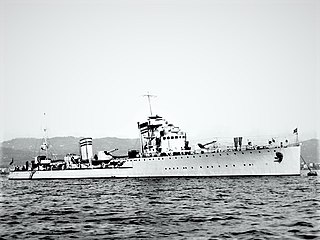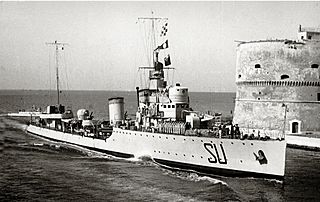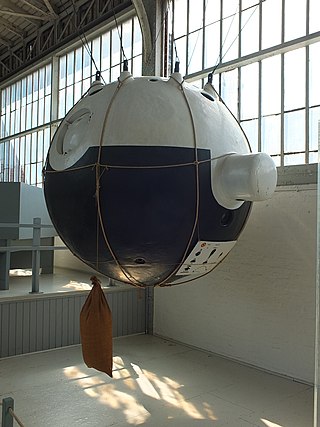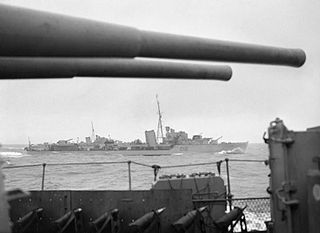
Auguste Antoine Piccard was a Swiss physicist, inventor and explorer known for his record-breaking hydrogen balloon flights, with which he studied the Earth's upper atmosphere. Piccard was also known for his invention of the first bathyscaphe, FNRS-2, with which he made a number of unmanned dives in 1948 to explore the ocean's depths.

HMS Kandahar (F28) was a K-class destroyer built for the Royal Navy during the 1930s, named after the Afghan city of Kandahar.

HMS Mauritius, pennant C80, was a Fiji-class light cruiser of the Royal Navy. The ship was built by Swan Hunter, Newcastle upon Tyne. She was named after Mauritius, which was a British colony when she was built and entered service in 1941.

A deep-submergence vehicle (DSV) is a deep-diving crewed submersible that is self-propelled. Several navies operate vehicles that can be accurately described as DSVs. DSVs are commonly divided into two types: research DSVs, which are used for exploration and surveying, and DSRVs, which are intended to be used for rescuing the crew of a sunken navy submarine, clandestine (espionage) missions, or both. DSRVs are equipped with docking chambers to allow personnel ingress and egress via a manhole.

Trieste II(DSV-1) was the successor to Trieste – the United States Navy's first bathyscaphe purchased from its Swiss designers.

The FNRS-2 was the first bathyscaphe. It was created by Auguste Piccard. Work started in 1937 but was interrupted by World War II. The deep-diving submarine was finished in 1948. The bathyscaphe was named after the Belgian Fonds National de la Recherche Scientifique (FNRS), the funding organization for the venture. FNRS also funded the FNRS-1 which was a balloon that set a world altitude record, also built by Piccard. The FNRS-2 set world diving records, besting those of the bathyspheres, as no unwieldy cable was required for diving. It was in turn bested by a more refined version of itself, the bathyscaphe Trieste.

The FNRS-3 or FNRS III is a bathyscaphe of the French Navy. It is currently preserved at Toulon. She set world depth records, competing against a more refined version of her design, the Trieste. The French Navy eventually replaced her with the bathyscaphe FNRS-4, in the 1960s.

HMS Amazon was a prototype design of destroyer ordered for the Royal Navy in 1924. She was designed and built by Thornycroft in response to an Admiralty request for a new design of destroyer incorporating the lessons and technological advances of the First World War. Their great rivals Yarrow produced a similar, competitive design — that of Ambuscade.

The Navigatori class were a group of Italian destroyers built in 1928–1929 for the Regia Marina, named after Italian explorers. They fought in World War II. Just one vessel, Nicoloso Da Recco, survived the conflict.

The Oriani class, were a group of four destroyers built for the Regia Marina in the mid-1930s. They were improved versions of the Maestrale-class destroyers and had increased machinery power and a different anti-aircraft armament. The increase in power, however, disappointed in that there was only a marginal speed improvement. The obsolete 40 mm/39 pom-pom anti-aircraft guns were finally discontinued, being replaced by extra 13.2 mm (0.52 in) machine guns; otherwise armament was unchanged.

The Maestrale class were a group of destroyers built for the Regia Marina and served in World War II. They formed the basis for subsequent Italian destroyer designs; the Oriani and Soldati classes.

The Sauro class were a group of four destroyers built for the Regia Marina in the late 1920s. They were based in the Red Sea Italian colony of Eritrea and all fought in World War II being sunk during the East African Campaign in 1941.

The National Fund for Scientific Research (NFSR) was once a government institution in Belgium for supporting scientific research until it was split into two separate organizations:

HMS Brazen was a B-class destroyer built for the Royal Navy around 1930. Initially assigned to the Mediterranean Fleet, she was transferred to Home Fleet in 1936. The ship escorted convoys and conducted anti-submarine patrols early in World War II before participating in the Norwegian Campaign in April–May 1940. Brazen later began escorting coastal convoys in the English Channel and was sunk in late July 1940 by German aircraft whilst doing so.

HMS Kashmir (F12) was a K-class destroyer built for the Royal Navy during the 1930s, named after the princely state of Kashmir in British India.

HMS Active, the tenth Active, launched in 1929, was an A-class destroyer. She served in the Second World War, taking part in the sinking of four submarines. She was broken up in 1947.

The Leone class were a group of destroyers built for the Italian Navy in the early 1920s. Five ships were planned and three completed. All three ships were based at Massawa, Eritrea during World War II and were sunk during the East African Campaign.
Norman Friedman is an American internationally known author and analyst, strategist, and historian. He has written over 30 books and numerous articles on naval and other military matters, has worked for the U.S. Navy and Marine Corps, and has appeared on television programs including PBS, the Discovery Channel, C-SPAN, and National Geographic.
Argo was the lead ship of her class of two submarines ordered by the Portuguese government, but taken over and completed for the Regia Marina during the 1930s.

The Pisani-class submarines were built for the Regia Marina during the late 1920s. They played a minor role in the Spanish Civil War of 1936–1939 supporting the Spanish Nationalists.



















